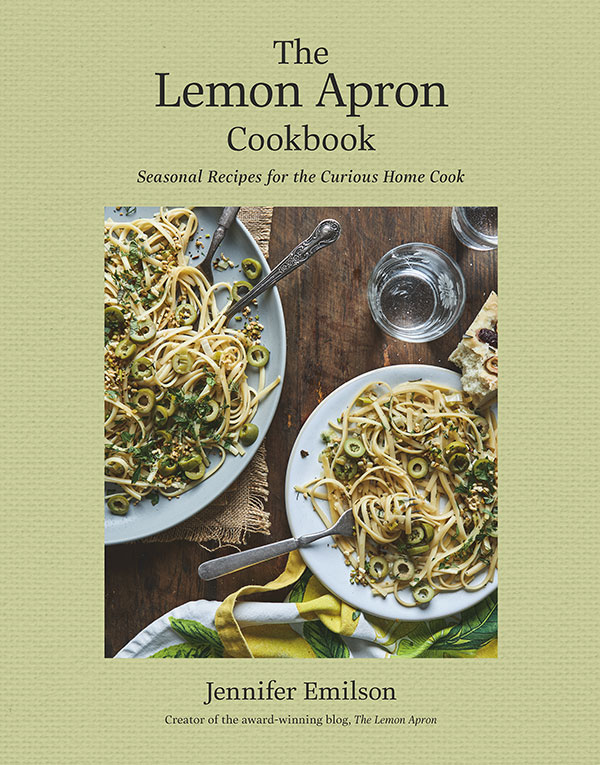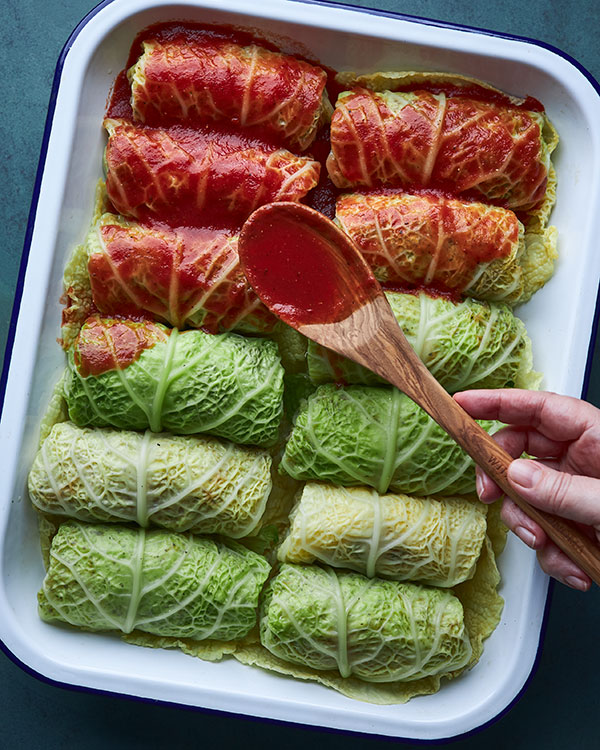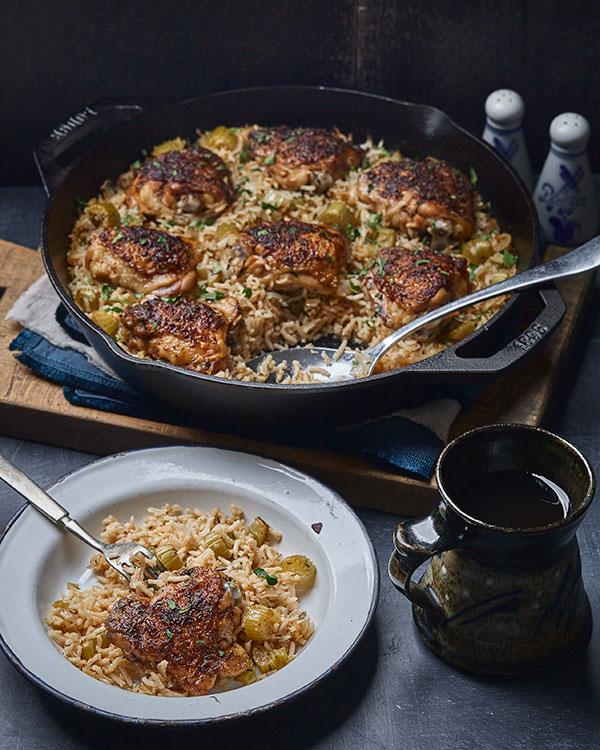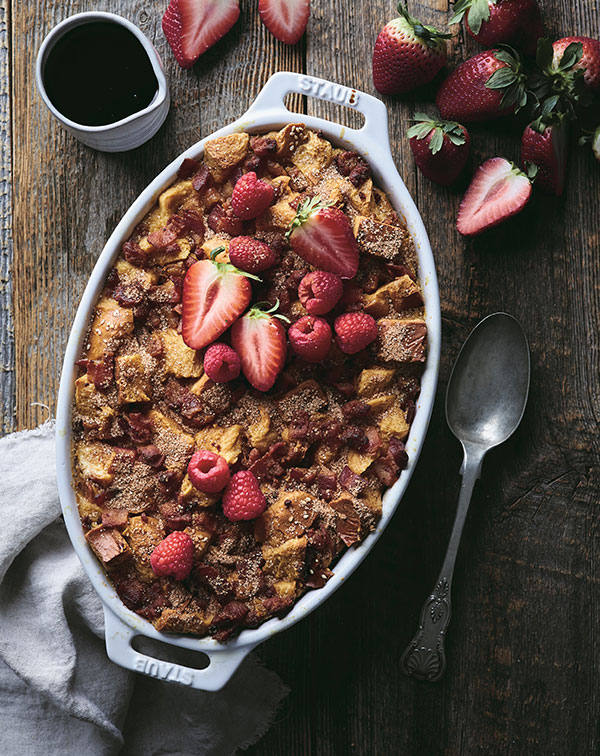Multicultural Recipes and Culinary Tips From Toronto Foodie Jennifer Emilson

An award-winning Toronto food blogger draws on her German heritage and cherished family recipes for her debut cookbook ‘The Lemon Apron’. Pictured above is Nuremburg Lebkuchen, a German honey cake. Photo: Johann Headley
Award-winning Toronto food blogger Jennifer Emilson draws on her German heritage and cherished family recipes for her debut cookbook, The Lemon Apron.
“All in my family are avid travellers, and connecting with new cultures and cuisines through the years has definitely also played a role,” she told Zoomer. “And living in such a multicultural city as Toronto has inspired my cooking for over two decades now.”
The book is chock-full of delicious ideas. One of my personal faves is her take on the Reuben sandwich, where you combine all those delicious ingredients — smoked meat, sauerkraut, cheese, rye bread, Russian dressing — on a sheet pan, stacked open-face, instead of cooking it grilled cheese-style on top of the stove. The result is toasty, gooey perfection without the messy flip. I will be making this again.
Writing the book during the pandemic meant Emilson faced challenges from ongoing food shortages, including flour, yeast and other staples. “But my local independent grocers and markets never let me down, and I actually got to know them all so much better through this journey,” she said. “This is something I wish for all my readers: get to know their local butchers, cheese mongers and small independent grocers; everyone will benefit from the bonds created.”
One of her favourite dishes from the book is Spiced Savoy Cabbage Rolls, which we share below, as well as several other tasty recipes you may be tempted to serve up over the holidays. But first some insider culinary tips from Emilson.

Cooking on a Budget: With rising food costs and inflation, many readers are looking for ways to stretch their dollars at the grocery store. Do you have any tips for this and dishes you would recommend?
Oh my, this is so true right now. We really need to return to the way our parents and grandparents shopped and treated food. Buy in season and preserve, freeze, etc. Purchase luxury items (even meat) when on sale and freeze: these days butchers are so good about vacuum packing whatever we want to put away for future use. A well-stocked pantry (see below) can be such a lifesaver. Recipes in my book — like Niçoise Tuna Melt — all take advantage of these pantry and budget-conscious ingredients.
Insider Tips: Can you share your favourite flavour boosters — and any other secret weapons?
First of all, lemon! It can brighten any dish, or cut through soups or stews, etc., that can be on the heavy or rich side. While I enjoy discovering and using unusual or new-to-me spices, I really do appreciate the basics: fresh parsley, paprika, garlic and citrus zests of all kinds. A secret weapon would be white pepper. I learned this one from my mum. It has a clear, pepper flavour, no fruity or smokey undertones, and has a bit more kick than black pepper. It really brings something special to a dish.
Easy Entertaining: What is your go-to dish for cooking/entertaining without the stress?
Spaghetti and meatballs! You’d think it would be something fancy, but I’ve come to realize that most of us just want to enjoy meals that make us smile. And who doesn’t like a good meatball!? This is a meal of very little stress; the meatballs can be prepped and even frozen well in advance (I always have a bag in the freezer for spontaneous dinners). The marinara sauce can be made in advance as well. Really, the only things you need to make before company comes are a salad, and cheesy garlic bread! And both of these can be prepped the morning of as well. Easy-peasy, and everyone is happy.
Must-haves: What items or ingredients do you keep stocked in your pantry and fridge?
Pasta, all the different beans, sardines, tuna, artichoke hearts, tomatoes, honey, hot sauces, olive oils and vinegars, crackers, chocolate, nuts and creme de marron are always in my pantry. There are at least three types of mustard, olives, four or five cheeses, mortadella, turkey and dried cured sausage in the fridge at all times. And eggs! At any given time, any combination of the above mentioned items can make a great impromptu Niçoise salad meal, charcuterie platter or antipasto pasta meal.
Finding Comfort: What is your go-to comfort food dish?
It most likely involves cheese! Grilled cheese sammie (the Welsh Rarebit in the book is a fun version) or mac ‘n’ cheese (there’s a cool German version in the book). If you ask my husband it will be meatloaf with mashed potatoes.
Snack Attack: What is your favourite snack, healthy and otherwise?
Eggs, in any shape or form! And if it’s for snacking in front of the TV, then popcorn.
Multigenerational: Favourite dishes to cook with the kids or grandkids
A fun ‘baking’ recipe is my Forgotten cookies. Basically chopped nuts and chocolate get folded into whipped egg whites. Then small mounds of this are put onto a baking sheet and put into a warmed oven. Turn off the oven and let the kids open the oven door the next morning to pull out the ‘baked’ cookies!
This Q&A has been edited and condensed
Recipes
Cabbage Rolls

If there is one dish that I most vividly remember my mum making, it’s cabbage rolls. I can see clear as crystal her slender fingers wrapping the tender cabbage leaves around the filling of meat, rice, and seasonings. She folded them in the most elegant manner, if making cabbage rolls can ever be elegant! After adding those little bundles to the casserole, she prepared her tomato broth (usually consisting of a large can of tomato juice!) and let it all simmer for a few hours. And while the cabbage rolls were in the oven, she made the mashed potatoes. Then we ate. However, I didn’t come to love cabbage rolls until I was older. Then I married Jim. If I made him cabbage rolls each month, his smile would be permanent. I always turn to savoy cabbage (the “winter cabbage”) for its ruffly, lacy leaves, so full of flavor and easy to fold. To keep things flavorful, I spice up the filling with coriander, Aleppo pepper, paprika, nutmeg, and white pepper.
Serves: 6
Makes: About 12 rolls
Prep Time: 1 hour
Cook Time: 2 hours
Ingredients:
1 head savoy cabbage
Filling
¾ cup long-grain white rice, rinsed
1 tbsp olive oil
1 large yellow onion, chopped 4 cloves garlic, minced
1 lb (450 g) lean ground beef
½ lb (225 g) ground pork
½ cup parsley leaves, chopped
¼ cup dill leaves, chopped 1 tsp salt
¾ tsp black pepper
½ tsp white pepper
½ tsp paprika
½ tsp cracked coriander seeds
½ tsp Aleppo pepper
¼ tsp ground nutmeg
2 eggs
Instructions:
- Bring a large pot of salted water (I use about 3 tablespoons of fine sea salt) to a boil. Use your hands to gently pull the outer leaves off the cabbage. As you get closer to the core, where the leaves are tougher, use a sharp knife to cut right along the core to release them.
- Working in batches if need be, gently slide the leaves into the water and cook until they are tender and pliable, about 3 to 4 minutes (depending how thick the rib is in the middle). Transfer the leaves to a tea towel. Repeat. Reserve 3 cups of the cooking water and set aside.
For the Filling:
- Add the rice and 1½ cups of water to a saucepan and bring to a boil over medium-high heat. Drop the heat to low and simmer, covered, until the water is absorbed and the rice is tender, about 18 to 20 minutes. Remove from the heat and let sit for 10 minutes. Gently fluff the rice. Transfer to a large bowl and let cool.
- In a skillet over medium heat, warm the oil and sauté the onions and garlic until just softened, about 4 to 5 minutes. Transfer the onions and garlic to the bowl of rice.
Mum’s Chicken and Rice

Whenever my mum asked what I wanted for dinner, I’d always say her chicken and rice. It wasn’t a German classic, but it was the most soothing meal I knew. The sublime way the chicken juices flavored the rice personified “home” for me. It took me forever to capture those flavors once I moved out on my own. I finally discovered the key ingredient—celery! My mum loved cooking with it. The right amount gives this a mild, earthy flavor that brings everything together.
Ingredients:
2 tsp sweet paprika
2 tsp dried thyme leaves
Salt and pepper
1 tsp lemon zest
1tsp onion powder
1 tsp garlic powder
1 tbsp olive oil
1 tbsp butter, divided
6–8 chicken thighs, bone in and skin on
1 large yellow onion, diced
2 cloves garlic, minced
3 stalks celery, chopped into
½-inch chunks 1 cup basmati rice
1¾ cups chicken stock
Olive oil cooking spray (optional)
2 tbsp finely chopped parsley, for garnish
Instructions:
- Preheat the oven to 350 F.
- In a small bowl, combine the paprika, thyme, 1½ teaspoons of salt, 1 teaspoon of pepper, the lemon zest, onion powder and garlic powder. Set this seasoning mix aside.
- In a large ovenproof skillet or braiser over medium-high heat, heat the oil and 1 tablespoon of the butter. Add the chicken thighs, in batches if necessary, skin side down. Sear on all sides until just golden brown, about 3 to 4 minutes per side. Transfer to a plate to cool slightly. Remove all but 1 tablespoon of the fat from the skillet.
- Place the skillet over medium heat. Add the onions and sauté until they just start to soften, about 10 minutes. Add the garlic and stir for another minute. Add the celery and 1 teaspoon each of salt and pepper. Cook until just softened, about 3 minutes.
- Meanwhile, once the chicken thighs have cooled, pat away any remaining fat and rub the seasoning mix into all sides.
- Add the rice and remaining butter to the skillet and stir to coat. Place the chicken evenly on top of the rice. Pour the stock and ½ cup of water around and between the chicken thighs, but not over top of them. Increase the heat to medium-high and bring to a simmer. Let it bubble for 30 seconds. Cover with a lid, or seal tightly with foil and bake in the center of the oven for 35 minutes. Remove the lid or foil. If you want the skins to be crispy, spray the chicken with a little olive oil cooking spray. Bake until the liquid is absorbed and the internal temperature reaches 165 F, about 10 minutes. Remove from the oven and let stand for 5 minutes. If serving from the skillet, gently fluff up the rice around the chicken. Garnish with parsley before serving.
Note: Searing the meat without seasonings ensures that the seasonings don’t burn onto the skin or into the pan.
Bacon and Sausage Bread Pudding

We were out for breakfast with friends one morning, and one of the guys freaked out when he saw me drizzle maple syrup over my bacon and sausage. You’d think I’d just committed armed robbery! This breakfast pudding is in direct retaliation to that incident. Think of it as the ultimate sweet-savory baked French toast. It’s everything you could want on a snowy morning, all trapped in one pan and with a crunchy cinnamon-sugar topping. There’s just a hint of heat, which works well with the maple syrup. This serves a crowd, but a smaller group can enjoy the leftovers, as they reheat wonderfully.
Serves: 8
Prep Time: 35 minutes + resting
Cook Time: 50 minutes
Ingredients:
1 (about 1 lb/450 g) loaf day-old bread
6¾ oz (190 g) bacon
13¼ oz (375 g) maple breakfast sausage, casings removed
5 eggs
¾ cup packed brown sugar
2 cups milk
2 cups heavy cream
4 tbsp butter, melted
1 tbsp vanilla extract
½ tsp salt
½ tsp chili powder
½ tsp cayenne pepper or chili flakes
Topping
1tbsp sugar
1 tsp ground cinnamon
Maple syrup, for serving
Instructions:
For the Bread Pudding
- Slice one piece of bread into a 1-inch-thick slice. If it’s too soft on the inside, slice the rest of the bread into 1-inch-thick slices and dry out the bread (see the Notes on page 119). Cut the bread into 1-inch cubes. Pack the cubes into a measuring cup and add to a large bowl. Repeat until you have 12 cups of bread cubes.
- Cut the bacon into ½-inch pieces and sauté in a skillet over medium heat until crispy and golden brown. Do not overcook; you don’t want it dried out. Remove with a slotted spoon and place on a paper towel–lined plate. Reserve 1 tablespoon of the fat in the pan.
- Add the sausage to the skillet and sauté carefully over medium to medium-high heat until just crispy and golden brown, breaking it into small pieces with the back of a wooden spoon as you cook.
- This may take as long as 15 minutes. Don’t rush it with too high a heat, or the meat may scorch. Drain on a separate paper towel– lined plate, blotting with paper towel as needed. Add to the bacon.
- In a bowl, whisk together the eggs, sugar, milk, cream, butter, vanilla, salt, chili powder and cayenne. Add three-quarters of the meat mixture to the bread cubes and toss to combine. Pour the egg mixture over the bread and toss gently to start soaking the bread.
- Spray a 9 x 13-inch baking pan with nonstick spray. Spoon the bread mixture into the pan and spread out evenly. Press down gently to get the bread to soak up all the liquid. Cover with plastic wrap and let sit for 20 minutes at room temperature.
- Meanwhile, preheat the oven to 325 F.
- Remove the plastic from the baking dish and sprinkle the remaining meat over top, gently pushing the pieces into the bread. Place the pan on a baking sheet and bake on the middle rack until a toothpick inserted in the center comes out clean, about 50 minutes. Let cool for 10 to 15 minutes.
For the Topping:
In a small bowl, mix together the sugar and cinnamon until evenly combined. Sprinkle generously over the entire top of the pudding. Serve with maple syrup!
Notes:
I have used panettone and brioche in this recipe with wonderful results. No matter which bread you decide to use, make sure it’s thick-cut and appropriately stale!
You can prepare the meat the day before you plan to cook the bread pudding. Store in an airtight container in the fridge until needed. Just let it come to room temperature before using. Leftovers will keep in an airtight container in the fridge for up to 3 days—but trust me, you’ll want to eat all of this up!
Nuremburg Lebkuchen

If you cut me open, you’ll probably find that I am made of Lebkuchen! Lebkuchen (or honey cake) is a German cousin of North American gingerbread. In addition to being sweetened by honey—instead of molasses— it contains a few different spices than gingerbread, most strikingly, white pepper and anise seed. Both help to create a unique but warm spice blend. Some of you may have reservations about its licorice leanings, but I promise, this is a good thing. Each area of Germany seems to have its own special version, but one of the most beloved is the Nuremburg Lebkuchen, also known as Elisenlebkuchen. Unlike most German baking, this is flour-free, relying totally on nuts, candied peel and eggs. There is something so spe- cial about the soft and chewy texture, the spices, and the interaction of the bittersweet chocolate with the sweet cookies. The aromas are downright heady when you open the container . . . even 3 weeks after you make them!
Makes: 32 to 36 cookies
Prep Time: 20 minutes
Cook Time: 22 minutes per batch
Ingredients:
Lebkuchen Spice Blend:
2¼ tsp ground cinnamon
1¼ tsp ground ginger
½ tsp ground cardamom
½ tsp ground cloves
½ tsp ground allspice
½ tsp ground nutmeg
¼ tsp ground white pepper
¼ tsp ground anise seed
Cookies:
3 eggs
1 cup + 1 tbsp (235 g) sugar
4½ oz (125 g) marzipan
¼ tsp salt
Zest of 1 lemon
½ cup packed (85 g) candied orange or lemon peel
½ cup packed (85 g) mixed candied peel (I like citrus)
1¼ cups (120 g) ground hazelnuts
1¼ cups (120 g) almond meal
½ cup (80 g) finely chopped blanched almonds
7 oz (200 g) dark or bittersweet chocolate
Sliced almonds, for decoration (optional)
Instructions:
Preheat the oven to 300 F.
For the Lebkuchen Spice Blend:
In a small bowl, whisk together the cinnamon, ginger, cardamom, cloves, allspice, nutmeg, white pepper and anise. Set aside.
For the Cookies:
- In a stand mixer fitted with the whisk attachment, or using a hand- held mixer and a large bowl, whisk together the eggs and sugar. Using the large side of a box grater, grate the marzipan into the bowl. Whisk again until well blended and slightly frothy. Add the Lebkuchen spice blend, the salt, lemon zest, candied peels, ground hazelnuts, almond meal and almonds. Switch to the paddle attachment or use a wooden spoon to blend well.
- Measure a sheet of parchment paper that will fit your baking sheet. Using a marker or pencil, trace circles, 2½ inches in diameter (a round biscuit cutter will guide you) and about ¾ inch apart. You should be able to draw about eight circles. Turn the parchment upside down and check that the markings are still visible. Spoon 1½ tablespoons or so of cookie batter onto each circle. Using a small offset spatula or your finger dampened with water, spread the batter to just fill the circle, leaving a bit more mounded in the center.
- Bake on the center rack of the oven until golden brown and slightly puffed, about 20 to 22 minutes. Transfer the baking sheet to a cooling rack and let the cookies completely cool on the sheet before removing. An offset spatula may help loosen them.
- Repeat the measuring and baking steps as many times as needed with the remaining cookie batter, using a new sheet of parchment for each batch.
- Once all the batches are completely cooled, coarsely chop the chocolate, place it in a metal bowl over a pot of simmering water and melt, stirring, until smooth and glossy. Let it cool for 1 minute. Use a silicone brush to spread the chocolate over the tops of the cookies. Make sure to get into every nook and cranny. If desired, decorate the cookies with the sliced almonds, lightly pressing them into the chocolate on top. Let cool completely.
Notes:
If you can’t find ground anise seed, simply crush whole anise seeds using a mortar and pestle, and use ¼ teaspoon as directed.
If you can’t find ground hazelnuts, toast 1 cup plus 2 tablespoons of whole hazelnuts in a dry skillet over medium heat, stirring occasionally, until fragrant and lightly browned, about 6 to 8 minutes. Transfer them to a tea towel, wrap well and rub them vigorously to remove their skins. Grind the cleaned nuts to a medium-fine meal in a food processor fitted with the steel blade. Stop as soon as this texture has been achieved, as going further will release the oils and you’ll find yourself with hazelnut butter!
The cookies can be stored in a sealed container at room temperature for up to 3 weeks or in the freezer for up to 4 months.
Excerpted from The Lemon Apron Cookbook: Seasonal Recipes for the Curious Home Cook by Jennifer Emilson. Copyright © 2022 Jeniffer Emilson. Cover and interior design by Lisa Jager. Cover and interior photography by Johann Headley. Published by Appetite by Random House, a division of Penguin Random House Canada Limited. Reproduced by arrangement with the Publisher. All rights reserved.
RELATED:
Cooking With a Conscience: 5 Waste-Free Recipes From Cookbook Author Christine Tizzard
‘Little Critics’: Canadian Celebrity Chefs Share Their Favourite Kid-Friendly Recipes
A Taste of India: Authentic Recipes From Culinary Experts Preena and Arvinda Chauhan